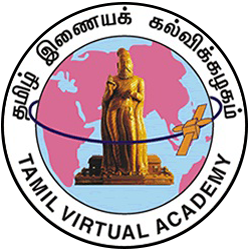Primary tabs
-
D02111 Aga Porul Ilakkanam - A General Introduction
This lesson offers a brief introduction to Aga Porul Ilakkanam. Tamil grammar is broadly classified into 5 major divisions - the word (sol), the letter (ezhuthu), content (porul), prosody (yappu) and figures of speech (ani). “Porul” is the content or the subject of any literary work. The ethics and codes governing the social and domestic life of the Tamils is largely the content or subject underlying ancient Tamil literature. Tamil grammarians used this content to devise the Porul Ilakkanam or the grammar that outlines the ethics governing life.
Porul Ilakkanam is classified into Aga Porul Ilakkanam and Pura Porul Ilakkanam. Pura Porul Ilakkanam is based on poems that deal with war and kingship. Aga Porul Ilakkanam is derived from poems that speak of the intangibles of life such as human emotions, love, separation and marriage. It therefore reflects the inner universe and codifies the behaviour and moral principles concerning love, courtship and marriage.
Aga Porul Ilakkanam is unique to the Tamil language. Of the 2381 poems in Sangam literature 1862 revolve around Aga porul or the themes of love and marriage. This shows that the ancient Tamils were a peace loving people who placed love and familial relationships above war.
The poems in “Nattrinai”, “Kurunthogai”, “Aingurunooru”, “Kalithogai” and “Aganaanooru” which are a part of “Ettuthogai”; “Mullaipaattu”, “Kurinjipaattu” and “Pattinappaalai” from “Pathupaattu”; and some of the works that constitute the “Keezhkanakku Noolgal” sing of aga porul.
The ancient grammar text ‘Tholkappiam’ has an extensive chapter on ‘agathinai iyal’. “Iraiyanaar Agaporul”, “Tamilneri Vilakkam”, “Nambiagaporul”, “Kalaviyal Kaarigai” and “Maaran Agaporul” are the 5 renowned texts on Agaporul Ilakkanam. These texts set out the agathinai ozhukkam, a literary convention that prescribes and codifies the emotions, conduct and behaviour appropriate to certain domestic contexts, especially love. Accordingly, the inner universe is divided into 7 tinais or modes: Kurinji, Paalai, Mullai, Marutham, Neithal, Kaikkilai and Perunthinai. Of these the first 5 are geographical landscapes each reflecting a specific mindscape. Kaikkilai and Perunthinai are the 2 non- geographical modes that deal with emotions that are abnormal or unnatural. ‘Paalathu Aanai’ (love seen as the result of Divine ordinance), ‘Kalavu and Karpu’ (i.e. clandestine love and post-marital love) and ‘Arathodunittral’ (seeking the consent of parents to marry the loved one) are the other aspects of agathinai ozhukkam.


